This post may contain affiliate links. Please read our disclosure for more info.
Do you keep falling out of your tree pose during your power yoga class? For some yogis, finding balance and stability can come easy. However, for others, it can be extremely challenging to stand on one foot. So what should you do when you find yourself constantly falling out of a balancing yoga pose? Yoga is meant to improve your balance and stability, but what do you do when you find yourself constantly toppling over?
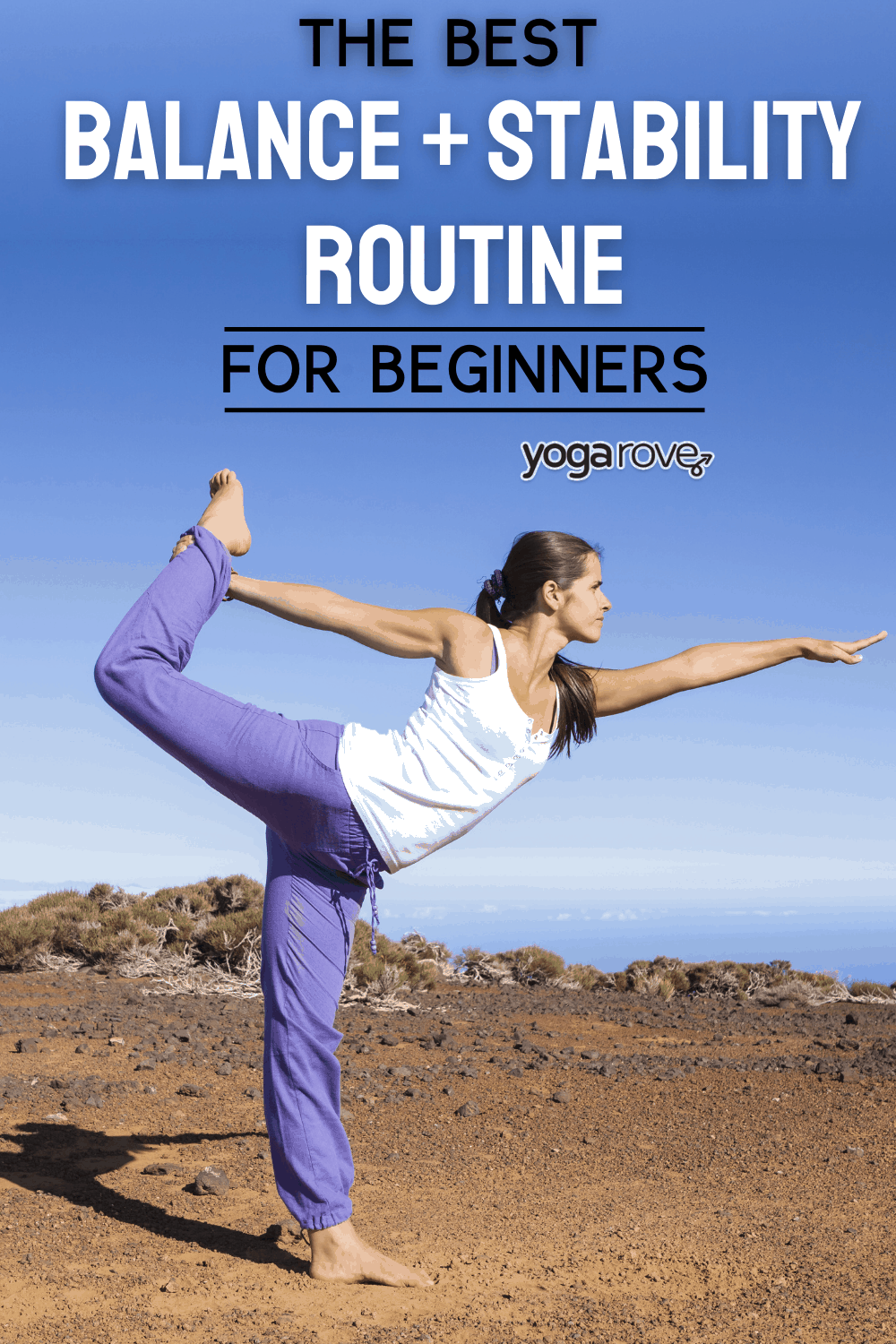
How can I improve my balance in yoga? Finding your balance on your mat now may be challenging, but it does not mean that you will not improve. Practice balance and stability yoga routines that help you to build flexibility, concentration, and strength. Over time and with consistent practice, you will begin to see improvement in your overall balance and stability.
As a yoga teacher, questions about improving balance and stability are ones that I frequently hear. Some yogis start yoga with the specific intention of finding more balance and stability in their bodies. With numerous balancing poses, there are different postures that you can start with and slowly begin to master as your balance and overall stability improves in your body.
When you first begin your yoga journey, it may seem impossible to find ease and stability in your balancing poses. But as with mastering any pose in yoga, it takes consistent practice and patience to begin to find that ease. While practicing yoga, there are many different tips that you can keep in mind to begin to cultivate more balance in your practice.
Why Is It Challenging For Me to Balance?
It’s not uncommon to be challenged by balancing poses in your yoga practice. There are many reasons why you may find yourself toppling over in Standing Bow. Here are some reasons why it may be challenging for you to balance in yoga:
- You are using the wrong muscles: You can be an extremely active person, but still fall over very easily when asked to balance on one foot. Standing on one or both feet requires the engagement of specific muscles in the body. Sometimes, even if you train in a specific sport or athletic activity, those activities may not engage the muscles needed for balance.
- You aren’t concentrating: Balance and stability require concentration and body awareness. It will be more challenging to find your balance if you are rushing into a pose without awareness and concentration. Take your time while coming into a pose, engage the muscles you need to engage, and allow for a quiet and stable concentration in the mind.
- You aren’t breathing: When we are in challenging moments or shapes, one of the first responses in your body may be to tense up and hold your breath. In yoga, we strive to find a calm and relaxed seat, no matter which shape we are in. So next time you find yourself holding your breath in eagle pose, take a deep breath, slow everything down, and work on connecting yourself to a grounding and strong energy.
Why Should I Improve My Balance?
It is important to have good balance and coordination for your overall health and well-being. Although we may not consciously think of it often, good balance is as important as building strength and flexibility in your body and is something that can be practiced and improved. The older that you get, the more at risk you may be to falls or accidents. It is a good idea to practice building up your balance and stability in order to stay strong and agile.
You should improve your balance to:
- Build your muscular strength
- Reduce the risk of injury
- Improve your focus and concentration
- Increase your agility and flexibility
Can Yoga Improve My Balance?
Yoga is one of the best ways to build your balance. A regular yoga practice has numerous benefits that aid in improving the stability and balance in your body. Because yoga works on strengthening your muscles, building flexibility, and improving concentration, you will find that your balance will start to improve after a few weeks or a few months.
There are many poses that work on finding stability in the entire body, and others that work on finding stability while standing on one leg, or even your hands. More importantly, yoga also helps you to find stability from your center, allowing you to build strength, agility, and balance.
Tips for Practicing Yoga for Balance and Stability
- Find your Drishti: Drishti, or focused gaze, is very helpful when practicing balancing poses. If you find that your eyes are constantly wandering around the room during practice, start to find a soft and steady gaze that you can hold. When we keep our gaze at one soft spot, it can be easier to find stability in your body.
- Engage your muscles: Is your body fatiguing while holding a balancing pose? Do you find that your knees or toes start to hurt while balancing on one foot? You may be hyperextending your joints, or relying on your flexibility to stay in a posture, instead of your strength. Focus on the muscles that you need to engage and start to slowly build up your strength in those muscles.
- Be patient with yourself: Remember that the journey of your yoga practice is more important than the destination. Embrace your journey of building strength, stability, flexibility, and balance in your body. Be kind to yourself by practicing patience and kindness, and celebrate the small victories along the way.
- Find your foundation: Whether you are balancing on one foot or both of your hands, feel yourself root down onto the ground to build a steady foundation. Make sure that you engage the muscles you need to engage and feel a sense of grounding and rooting on your hands or your feet.
- Relax your mind: Do you find your mind wandering and is that causing you to fall out of a pose? Steady your mind and your body will follow. Allow yourself to tune into your breath and body while practicing, instead of thinking about how difficult a moment is. When you surrender to the moment and breath, you allow your mind to relax and it may be easier to find stability in your physical body.
Yoga Routine for Balance and Stability
If you have around 30 minutes during the week, try this yoga routine to improve your balance and stability. There are 3 parts of the yoga routine– the warm-up, the balancing poses, and the cool down. Each section should take about 10 minutes to practice.
Warm-Up
It is essential that you take the time to warm up your body. Feel free to take a little longer in each pose, and focus on building the connection to your breath.
Tabletop
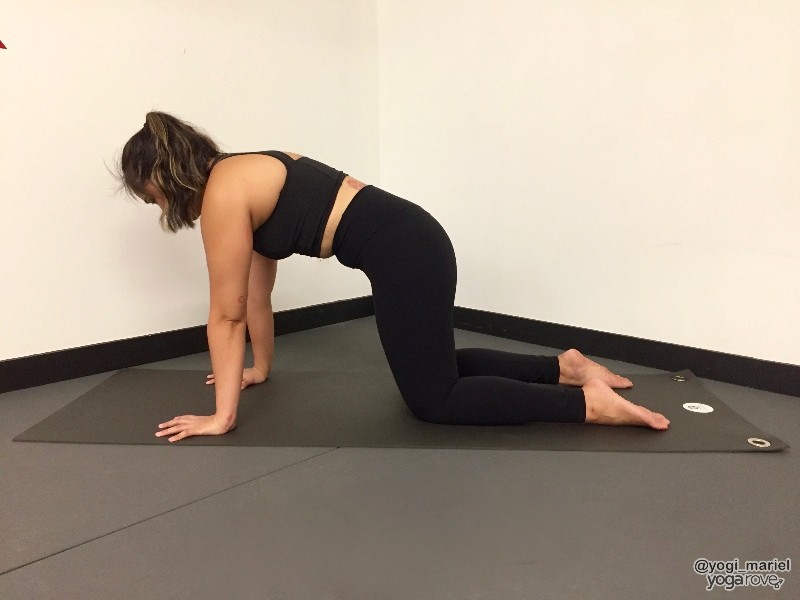
- Begin at the center of your mat with your hands underneath your shoulders and your knees underneath your hips.
- Find a strong and steady foundation by spreading your fingers wide and rooting the heels of your hands down onto the mat.
- Draw your belly button toward your spine to activate your core. Push the mat away and keep your core engaged.
- Stay for 5 breaths.
Downward Facing Dog
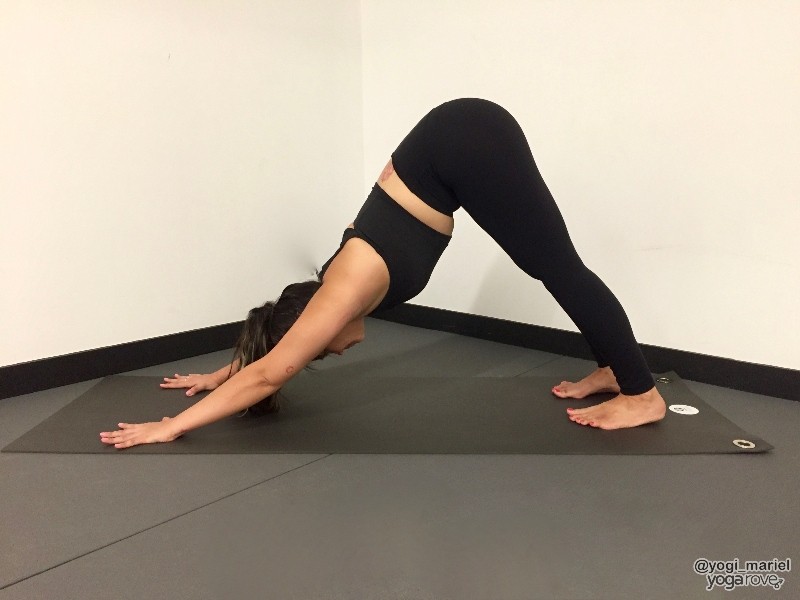
- From your hands and knees, walk your hands a few inches forward and spread your fingers wide on the mat.
- Curl your toes under and lift your knees and hips off the mat.
- Lift your hips up toward the ceiling, and as you push the mat away from you, lengthen your spine.
- Allow your knees to bend if that feels more comfortable. If you bend your knees, keep your heels off the floor, and work on finding length in your spine and your side body.
- Stay for 5 breaths.
High Plank Pose
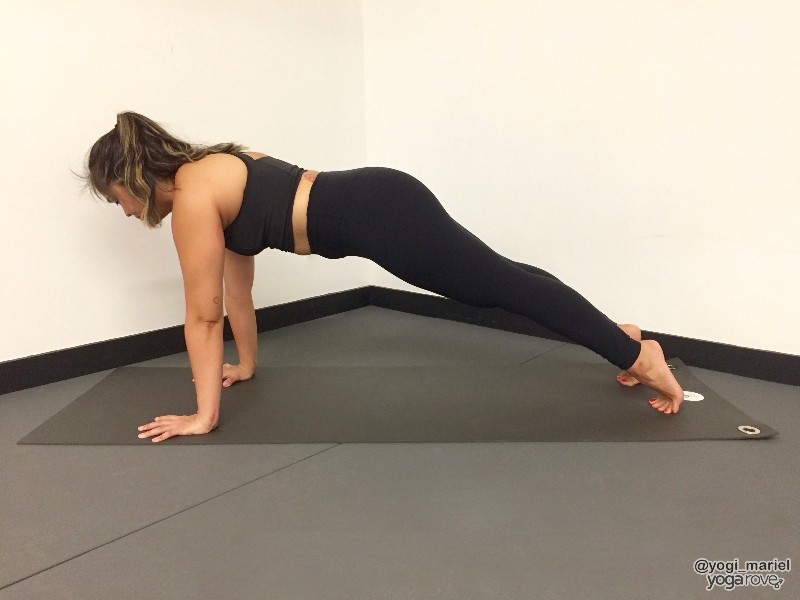
- In your downward facing dog, lift up onto your tiptoes and lift your heels off of the mat.
- Bend both of your knees and ripple forward into a plank position.
- Check that your shoulders are over your wrists, your legs are straight, your core is engaged, and shoulder blades are squeezing slightly down your back.
- Push the mat away while keeping your belly button in toward your spine, and lift up through the backs of your knees.
- Stay for 5 full breaths and push back to the downward facing dog.
Ragdoll
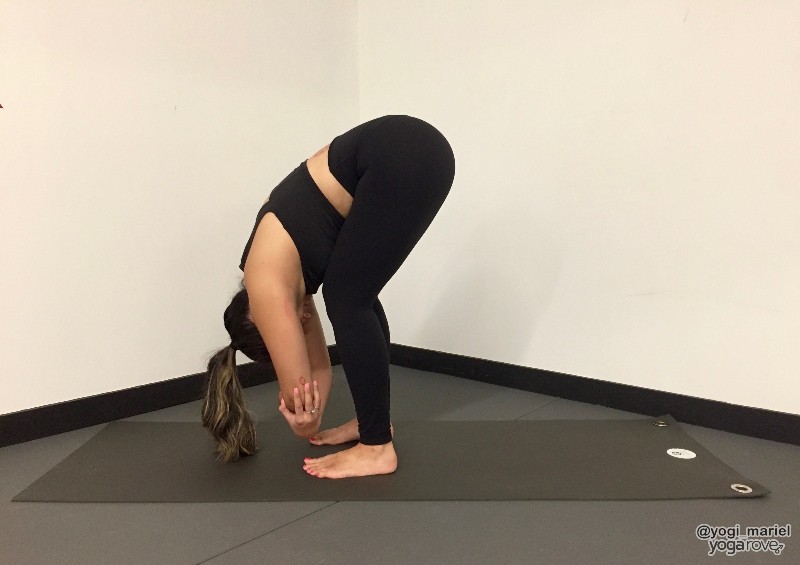
- Bend your knees again and look to the top of your mat.
- Walk your feet forward and take your feet apart hips-width distance.
- Allow your upper body to hang heavy and reach for opposite elbows.
- Allow your knees to bend deeply and let your head hang heavy. Feel your shoulders to relax away from your ears and your stomach resting on your thighs.
- Add some movement with the head, neck, and shoulders to loosen everything up. Focus on feeling your feet root down to the mat.
- Stay for 5 breaths.
- To come up, soften your knees, draw your belly button in toward your spine and slowly round your body up, letting your head come up last.
Mountain Pose
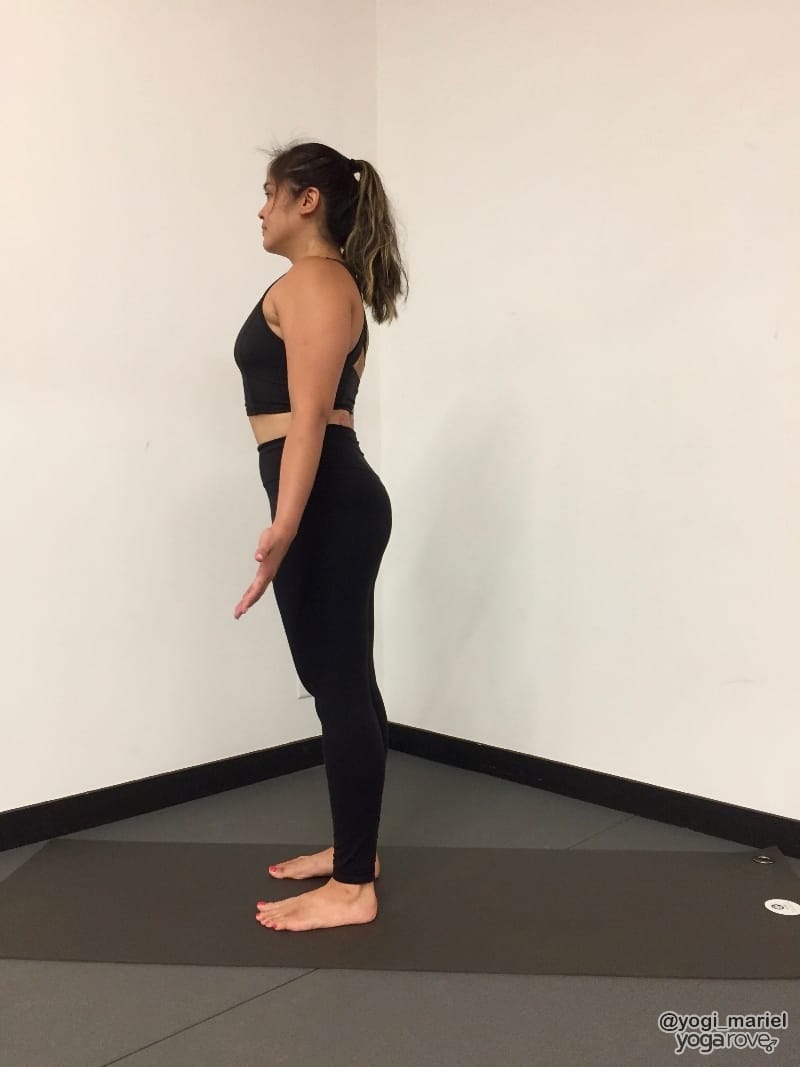
- Keep your feet apart hips-width distance and allow your arms to relax alongside your body with your palms facing forward.
- Relax your shoulders away from your ears, lengthen your spine, and draw your ribs in.
- Move awareness to your base, and root down through your heels and big toes.
- Engage your thigh muscles by lifting your kneecaps up, and keep your core engaged.
- Close your eyes and take 5 deep breaths, feeling stable and rooted on both of your feet.
Modified Sun Salutation B:
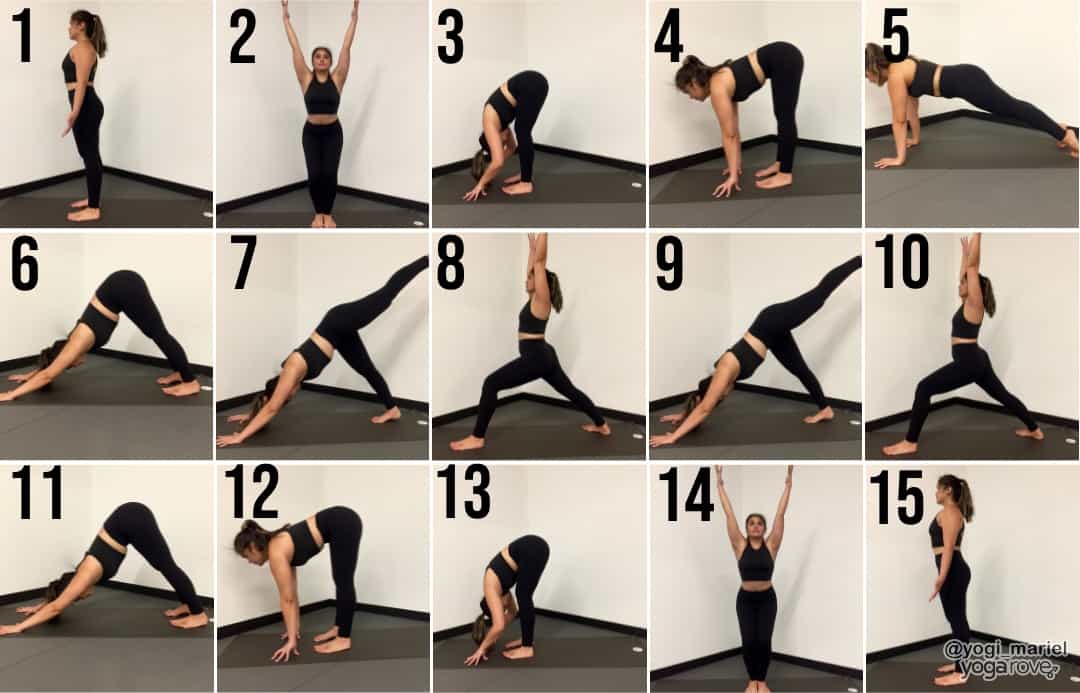
- From Mountain pose, take your big toes to touch and bring your heels slightly apart. Bend both of your knees as if you are sitting on a chair and lift your arms up overhead. Take our palms to face each other, relax your shoulders, and engage your core. Feel the weight on your heels.
- As you exhale, swan dive down in a forward fold. Feel free to bend your knees on the way down, but keep your belly button drawing inward and engage your core.
- Inhale for a halfway lift. Look forward, place your fingertips on your shins or the ground, and bend your knees if needed. Lengthen your spine and lift your chin away from your chest.
- Exhale and bend your knees, plant your palms flat on the mat and step back into Plank pose. Check that your hands are underneath your shoulders, your core is engaged, and your legs are strong. Take one full round of breath and push back to downward facing dog.
- Inhale to lift your right leg up in a down dog split. Step your foot forward in between your hands and root down through your back heel. Rise up with the arms up overhead into Warrior 1. Square your hips to the front of the room, while rooting down through your back heel and baby toes. Stay for 5 breaths and focus on finding grounding and stability in your legs and core.
- Plant your palms down on the mat and step back to downward dog. Repeat down dog split into Warrior 1 on the left side.
- From downward dog, lift up onto your tiptoes, bend your knees, and look forward. Step or jump to the top of your mat.
- Inhale to half-lift and exhale for a forward fold.
- Inhale back to chair pose. Exhale to mountain pose.
- Repeat up to 3 rounds of this modified Sun Salutation.
Balancing Poses
Now that your body is warmed up, try these balancing poses. Remember to be patient, take your time, and modify if needed.
Supported Warrior 3
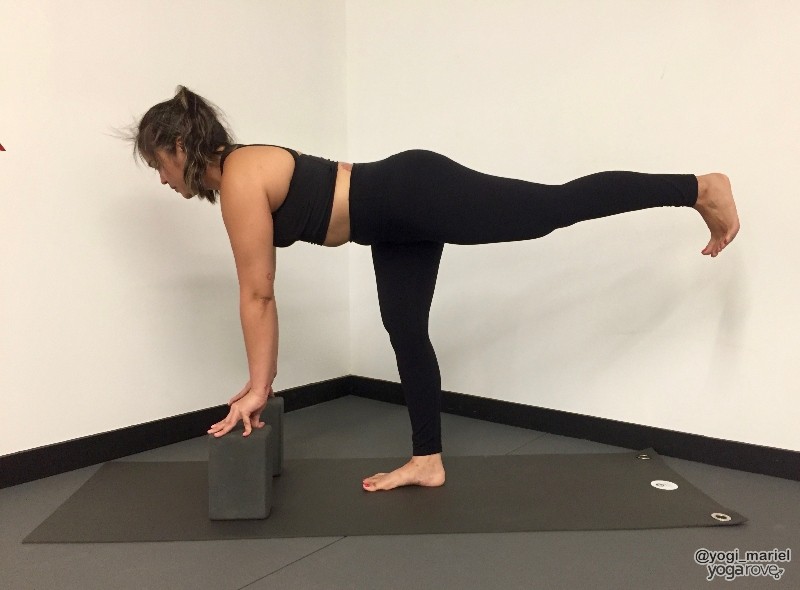
-
- Start in downward facing dog.
- Step your right foot forward in between your hands and check that your toes are pointing straight forward.
- Walk your fingertips in front of you and take your hands underneath your shoulders. Feel free to use blocks underneath your hands for more height and support.
- Begin to lift your back toes off the floor and find a capital T shape with your body, while keeping your fingertips on the ground or on your blocks.
- Square your hips, lengthen your spine, and keep both of your legs active and engaged.
- Feel stability in your core, and continue to root down through your standing foot and leg.
- Stay for 5 breaths and step back to downward dog. Repeat on the left side.
Eagle pose
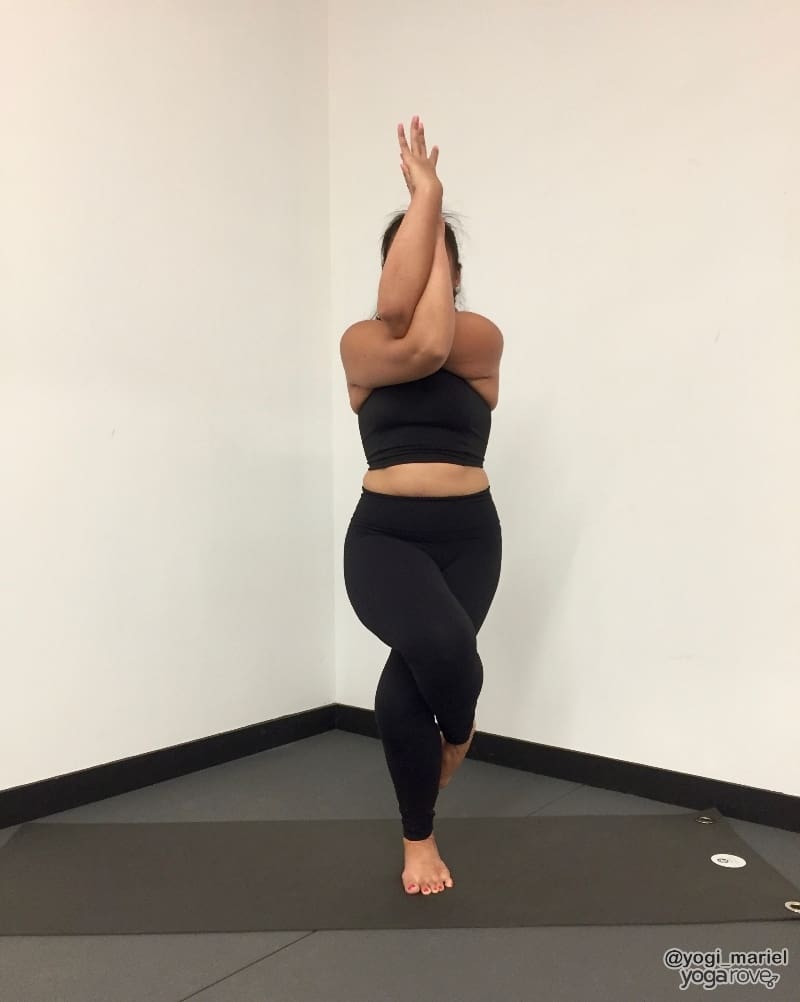
-
- Start in Mountain pose. Inhale your arms up overhead.
- Cross your right arm underneath your left arm and reach for opposite shoulders, or interlace your fingers in front of you.
- Sit low in chair pose and swing your right leg up and over your left leg, crossing your thighs and possibly wrapping your right ankle around your left calf muscle.
- Squeeze everything toward the midline of your body and feel your body weight to your left heel.
- Sit low, lift your chest up and relax your shoulders, while finding one spot to focus on in front of you.
- Stay for 5 breaths and switch sides.
Tree Pose
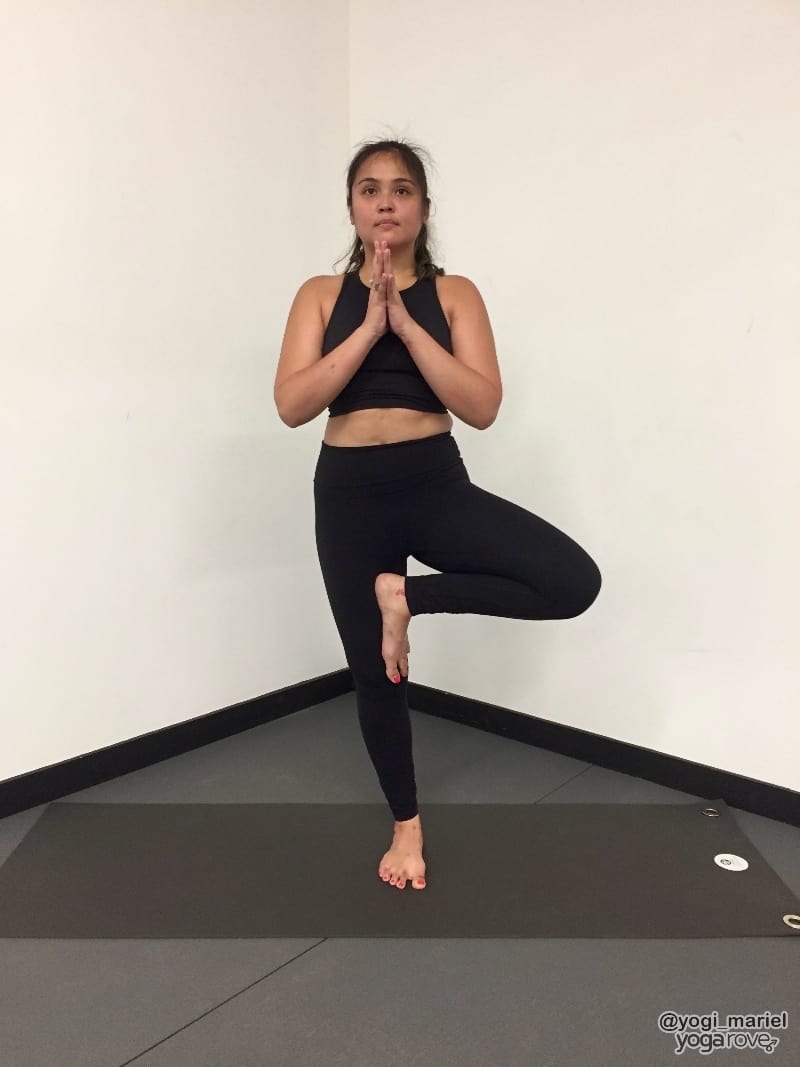
-
- Beginning in Mountain pose, shift your weight to your left leg.
- Find your rooting through the heel and big toe and engage your thigh muscle by lifting your kneecap up and squeezing your muscles to the bone.
- Lift your right knee up into your chest and open your knee to the right side of the room.
- Using your hands, place your right foot to the inner left thigh, ankle, or calf muscle.
- Make sure that you avoid putting direct pressure on your knee. Push your foot into your leg and your leg into your foot.
- Gently bring your hands to your heart center or take them up over your head.
- Find your Drishti and take 5 slow deep breaths. Repeat on the left side.
Cool Down
End your practice with these restorative poses. Take as long as you would like in these finishing poses.
Modified Bridge Pose
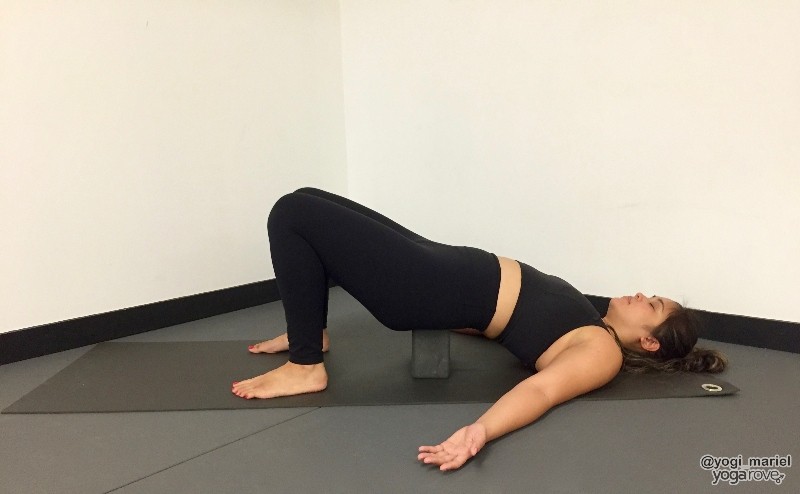
-
- Lay down on your back with your feet hips-width distance apart and toes pointing straight forward. You can place a block in between your knees, and gently squeeze the block to feel everything hug toward the centerline of your body.
- Take your fingertips to graze your heels and your palms to face down to the floor.
- Inhale to lift your hips off the mat. Keep rooting your heels down and squeezing towards the midline. Keep your palms flat on the floor and lift your chest.
- As you exhale, gently lower everything down.
- Repeat with your breath for 5 rounds.
Happy Baby
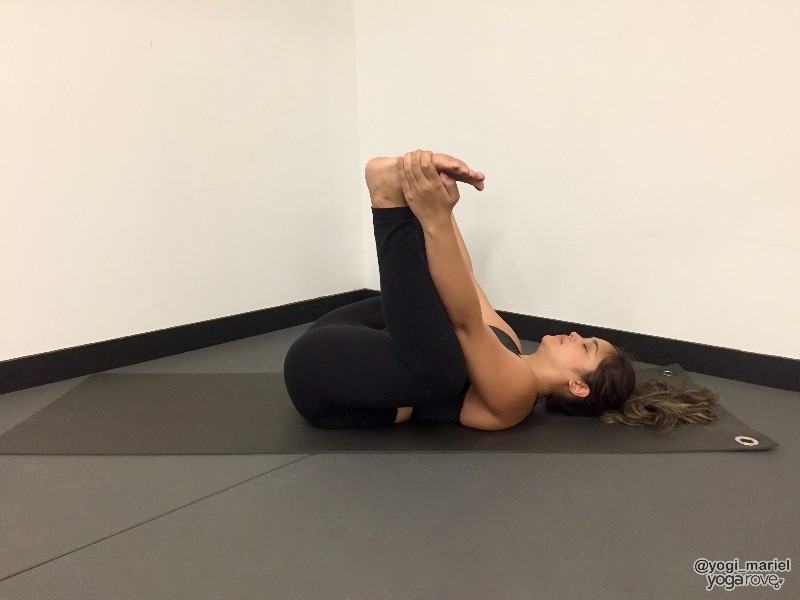
-
- Hug both of your knees into your chest and reach for the outside edges of each foot.
- Flex your toes and take your knees apart while you gently pull your knees toward the mat.
- Find some movement if you would like and keep your tailbone on the floor.
Savasana
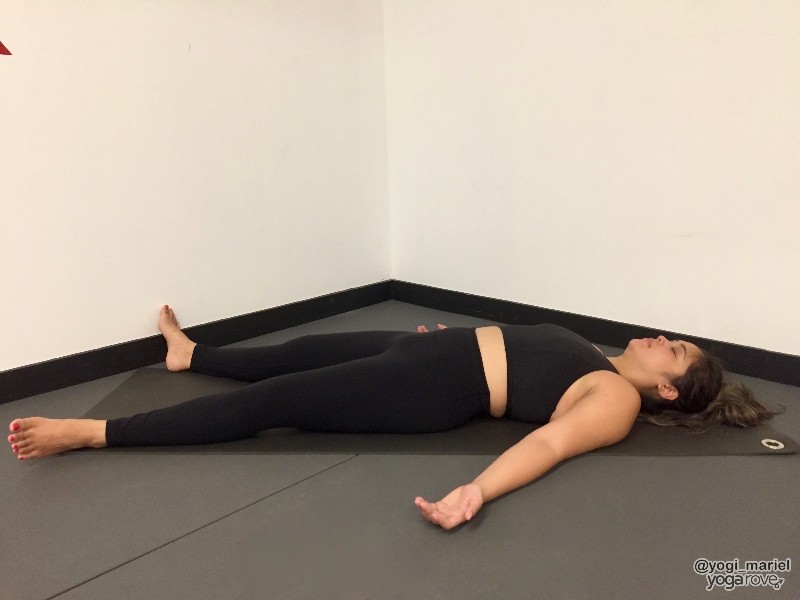
-
- Lie down on your back, allow your palms to face up, and close your eyes.
- Let yourself completely relax for at least 2 minutes.
Related Questions
How can I modify Eagle pose? There are countless ways that you can modify eagle pose. If you can’t quite balance on one foot, you can always place your toes on the floor as a kickstand for more support. If it is challenging to wrap your arms around, you can follow these modifications.
What are some arm balancing postures? Arm balancing postures are poses in which you balance on your hands. Instead of having your feet to the foundation of the pose, your hands serve as the grounding force in your shapes. Some arm balancing poses include crow pose, handstand, and eight-limbed pose.


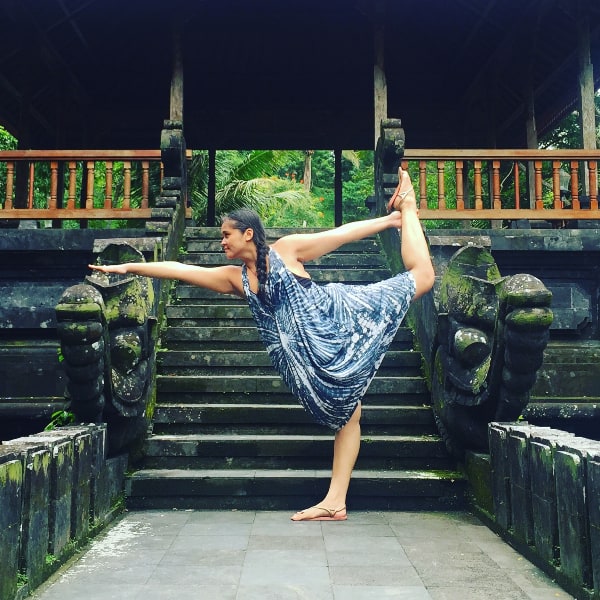
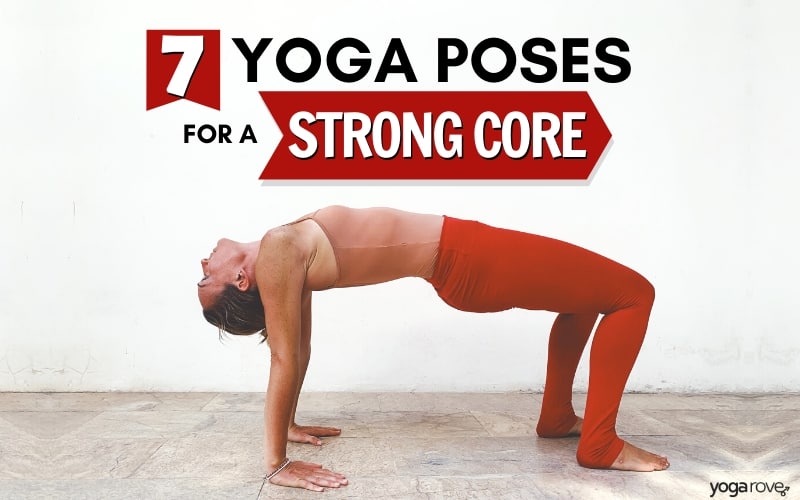
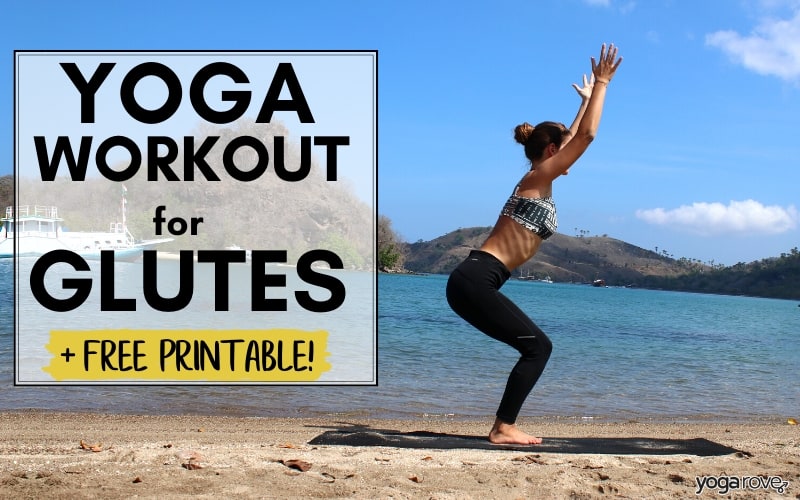
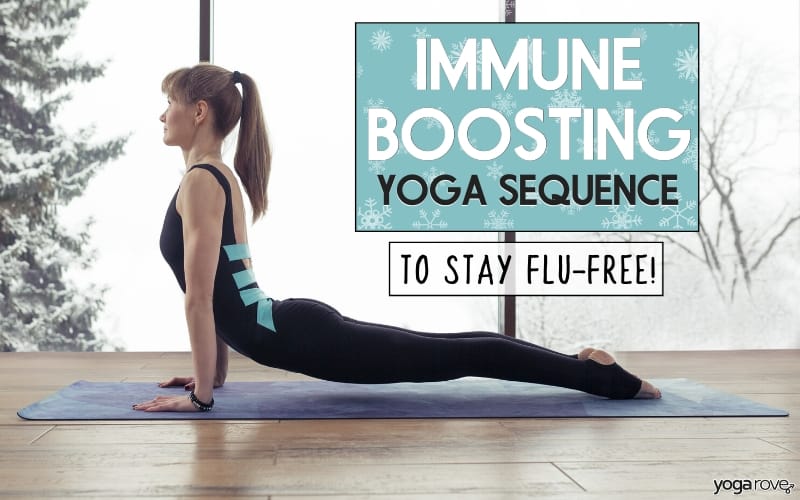
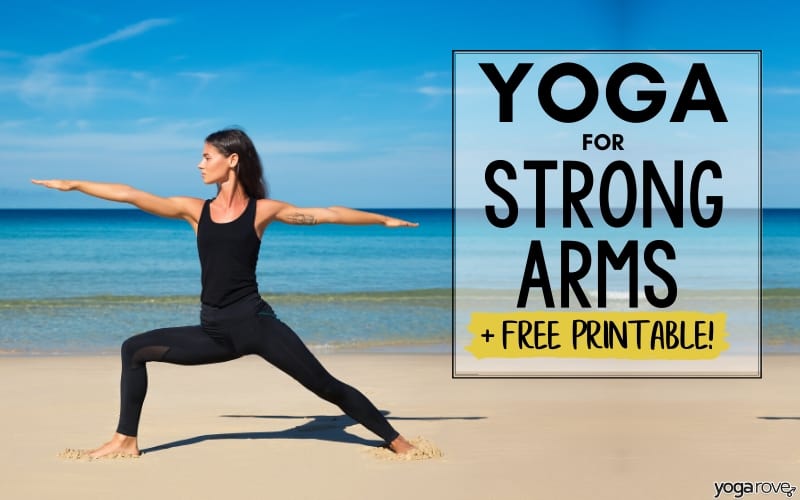
Very very good. Thank you very much.
Glad you enjoyed it Mohamad!
Thank you for this article.
“What’s your biggest struggle in finding balance in your practice?”
I imagine my answer will be unique in as much as I have one leg. Your lessons provide me with explanations and techniques for many issues already and I will continue to learn from them.
Thank you
Always appreciate your feedback Robert! So glad you found it helpful 🙂
Useful.
Glad you found it helpful Narendra!